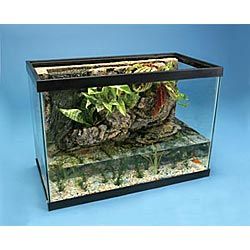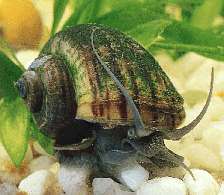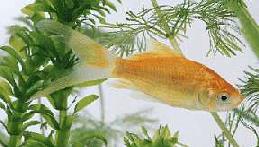My Cart
Your Shopping Cart is currently empty. Use Quick Order or Search to quickly add items to your order!
By Christopher H. Randall
Center for the Enhancement of Science and Math Education,
Northeastern University, Boston, MA 02155
Imagine your students making observations and direct measurements of a stream ecosystem, gaining insight into its dynamics, and developing an appreciation of its complexity without ever leaving the classroom. The River Tank System is being used to conduct engaging, classroom-based "field studies" in biology and chemistry classes throughout the country. Finn Strong, the inventor of River Tank, originally envisioned this habitat as being popular with aquarium enthusiasts and in home and office displays. Not surprisingly, however, teachers have given the tank an enthusiastic reception, and it has become a versatile and valuable teaching tool in elementary, middle, and high school.
The River Tank combines elements of an aquarium, a terrarium, and an animal exhibit to produce a dynamic habitat where plants, animals, and microorganisms interact in ecological balance. A River Tank consists of an aquarium tank with a decorative and functional form with molded -in planting pockets and ledges to mimic a rock face such as might be found in a small mountain stream. A pump in the bottom of the tank sends water through a tube up the back of the form to flow through a channel before cascading down to return to the bottom of the tank. Some of the water also flows into the plant pockets, cascading from one pocket to the next. In this way water is recirculated throughout the system. The result is a series of mini-habitats, shallow and deep pools, slow and swift currents, rapids, eddies, and waterfalls, all connected by the flowing water.
Unlike a traditional aquarium, the River Tank also serves as a terrarium with cavities and ledges providing places to grow a variety of plants. These plants utilize fish waste and help keep the tank in balance by removing nutrients from the water. Reflecting the diversity of life in and around a stream, lizards and amphibians can use the banks and ledges as living areas.
Finally, the River Tank is designed to promote robust bacterial growth. Bacteria grow on practically every available submerged surface in the tank, and the plant pockets vastly increase the surface area available for the growth of bacteria. Because the water is so well oxygenated and seeps slowly through the gravel, it promotes an ideal, aerobic environment for beneficial bacteria. By supporting such large, healthy bacterial populations, the River Tank is well equipped for biological filtration without the need for bulky, expensive add-on filter units.

There are five environments in the River Tank - underwater in the slow currents, underwater in the fast currents, a bog, the water's edge, and high above the water on the ledges. A class might consider how many different types of organisms can live successfully in the tank and populate each of these environments. Leeches, crayfish, snails, worms, fish, salamanders, Anoles, newts, insects, bacteria, algae, higher plants, and many protists all can be successfully raised in the River Tank, but questions remain as to which ones can coexist, and for how long, before being eaten by another inhabitant.
Likewise, by describing the characteristics of the plants that grow in these different environments, students gain an understanding of the concept of niches. They can predict which plants will thrive and can test their predictions by establishing a viable plant community in the tank.
Establishing the fish collection poses a similar challenge for students. For example, the 20-gallon tank holds about 12 gallons of water and can support 12 to 16 fish. A class might consider the following questions when determining which fish to include:
Once the fish colony is established, students can investigate additional questions:
By determining the roles that plants, animals, and microorganisms play in the River Tank system, students gain insight into the relationship between producers, consumers, scavengers, and decomposers. Furthermore, by studying its chemistry, students realize how utterly dependent the biotic community is on the abiotic components of the system (i.e., light, temperature, inorganic compounds, and oxygen and carbon dioxide levels).
A class could synthesize its understanding of all that is required to create a balanced ecosystem by modeling a particular type of stream. Since aquarium fish come from all over the world, a class could set up a tank to represent a particular continent or biome and choose plants and animals accordingly. Students also could contrast various stream ecosystems by setting up multiple tanks or by making picture essays or oral presentations.

Such projects would raise important questions about the extent to which one can accurately model a natural ecosystem, and about how the River Tank differs from such a natural system. With such questions answered, the River Tank serves as an ideal introduction for a field trip to a local stream or river, enabling a class to maximize the value of its visit.
The questions raised by establishing a balanced ecosystem in the tank can be the basis for sparking class discussion and for generating research projects. By reflecting on what they learned, students become sensitive to the effects of destroying part of an ecosystem or of removing a particular organism. They also consider more complex issues, such as whether endangered species are worth saving even if doing so severely impacts the local economy, or whether a closed system, such as an aquarium or space station, can really be self-sustaining.
Finally, a tremendous amount of supplementary information about organisms, habitats, niches, and ecosystems is available on CD-ROM, laser disk, and video. Viewing some of these images or using them to create a multimedia presentation gives students exciting opportunities to connect what they are learning in class to the world around them.
If there are not too many herbivores in the tank, students will soon see several varieties of algae growing. While advanced students can key out the specific types of algae, the entire class can have direct experience with the concepts of habitat and adaptation using a much less technical approach. By observing colors, growth patterns, and the location in the tank, all students can easily differentiate one type of algae from another. Where did the algae come from in the first place? Why does a particular alga grow in one place but not another? How does the distribution of algae change over time?
Quite naturally, students will begin to discover how minuscule changes in the environment give one species an advantage over another. Ultimately, rather than conceiving of an ecosystem as comprised of several well-defined habitats, students will see that each habitat can itself be divided into many microhabitats.
Identifying the characteristics of the microhabitats is a valuable exercise in problem solving. For instance, one challenge could be to figure out how to observe differences in the flow characteristics of the tank's waterfalls, pools, and rapids. This might be done by watching the movement of strings, which can be attached to glass rods embedded in the gravel or to suction cups mounted on the glass. Long, flexible plants can also serve as natural, qualitative flow indicators. Students could then create their own "wiggle scale" to describe the amount of turbulence.
In addition to flow rate, the River Tank's microhabitats are influenced by light intensity, moisture levels, and substrate differences. Once the microhabitats have been tentatively identified, students can collect samples from each site to make direct observations and confirm whether the algae, diatoms, and bacteria are indeed different at each site.
Collecting samples can be done by scraping off small amounts of material, by examining what grows on the flow-indicator strings, or by using settling plates. Microscope slides can be used as settling plates. Set the slides on flat surfaces or insert them into the gravel. Leave them in place at least one week, preferably longer. Once the samples are collected, students can hone their lab skills by observing and describing the samples under the microscope.
Of the waste products fish excrete, ammonia, phosphorous, and undigested food impact an aquarium most significantly. Simple test kits are available for keeping track of the changing water chemistry of a River Tank. Phosphorous occurs principally as dissolved phosphate and, since phosphate is often a limiting factor in plant growth, it is quickly removed by the plants directly. Undigested food and some by-products of digested food, namely amino acids and proteins, are a major source of dissolved organic compounds - a major component of the detritus that accumulates on the gravel bed and in the filters. This detritus is essentially harmless, but it clogs the filters and coats the gravel, limiting the ability of any carbonate particles in the gravel to dissolve and help buffer the water.
Ammonia (NH3), is toxic to fish and must be removed or converted
into benign substances before it builds up to lethal levels (levels above
0.1 ppm are considered dangerous). Some of the ammonia is taken up directly
by certain plants (including most algae), but most of it is converted to
mildly toxic nitrite (NO2-) by Nitrosomonas bacteria. Nitrobacter bacteria then convert the nitrite into nitrate
(NO3-), a relatively benign, useful compound.
Nitrate is quickly removed from the water by plants, which use it as a source of nitrogen to form proteins and nucleic acids. This processing of ammonia to nitrate is part of what is commonly referred to as the nitrogen cycle. Regular testing of the ammonia, nitrite, and nitrate levels gives a good sense of the robustness of the Nitrosomonas and Nitrobacter populations. Testing also provides insight into how well balanced the tank is in terms of the amount of waste generated and the ability of the bacteria to process that waste.
The pH of aquarium water is another important measure because fish are adapted to living within specific pH ranges; bacteria are sensitive to pH levels as well. African cichlids, for example, prosper in alkaline waters with a pH range of 7.4-8.0, while certain tetras thrive in acidic waters with a pH range of 6.0-6.2. If a fish is forced to live in a pH level outside its preferred range, its slime coat can suffer, making it susceptible to disease. Its fecundity drops and, ultimately, the gas exchange in the gill membranes will be so reduced that the fish may suffocate.
Nitrosomonas and Nitrobacter prefer an alkaline environment (pH 7-8), and pH levels much below 6 severely curtail their activity or kill them. Once the bacteria are gone, the toxic ammonia quickly builds up to levels that will kill all the fish.
In an aquarium, acids derive primarily from two sources. The first is when carbon dioxide (directly dissolved into aerated water or released as a respiration by-product) mixes with water to form carbonic acid.
The other is when ammonia undergoes nitrification by Nitrosom onas.
Should any part of the tank become anaerobic, the heterotrophic, bacteria producing, organic (eg., lactic, acetic, and formic) acids will add to the acid load of the tank and lower its pH through fermentation.
An underappreciated source of periodic pH swings is photosynthesis. During illumination, plants take in carbon dioxide, raising pH as the amount of carbonic acid (one source of carbon dioxide) in the tank is reduced. At night, respiring plants release carbon dioxide; consequently, the amount of carbonic acid in the tank increases, lowering the pH.
Water hardness is an often overlooked though extremely important component of pH balance in an aquarium. Water hardness refers to the total concentration of calcium and magnesium ions in the water, primarily from calcium carbonate (CaCO3) and magnesium carbonate (MgCO3). These ions, called buffers, are important because they slow the rate at which the pH changes.
The equation below shows that carbonic acid (H2CO3) dissociates into hydrogen (H+) and bicarbonate (HCO3-) ions. The bicarbonate ions can further dissociate into hydrogen (H+) and carbonate (CO3-) ions. When acid (H+) is introduced into well-buffered water, carbonate ions react with the hydrogen ions to produce bicarbonate. Thus, even though acid is added, no change in the overall pH occurs. Furthermore, bicarbonate ions act as an additional reservoir for hydrogen ions. The reactions outlined in the equation below are pH sensitive and shift to the right as pH increases.
If the aquarium water is not well buffered (5.6-11.2 dKH or 100-200 ppm calcium carbonate in a freshwater tank), any acid that is added serves to drive down the pH. Consequently, the daily pH swings caused by photosynthesis can combine with longer-term acid accumulations and cause the tank to suddenly crash because of catastrophically low pH levels.
Oxygen is required to keep fish healthy and active and to maintain an aerobic environment that will support a robust, aerobic bacterial colony. The River Tank's waterfalls and rapids aerate the water and keep it well oxygenated. A comparison of the oxygen levels between the River Tank and a container of standing water would demonstrate the role agitation and mixing play in maintaining oxygen levels. The agitation also helps dissipate any chlorine in the water which escapes at the surface as chlorine gas.
The River Tank can be used to enrich a broad number of science topics as well as serve as a source of problem-solving challenges. For example, when conducting field studies of a stream, scientists draw a cross-sectional profile of the stream and calculate its rate of flow. Students might devise a way to do this using the tank.
Interesting comparisons between the River Tank and traditional aquariums can be made. In addition to the comparison of oxygen levels mentioned previously, students can compare the evaporation rates of the two types of tanks or discuss what types of plants and animals are best suited for each type. Temperature stratification is another important difference between flowing and standing bodies of water. Students can determine if the water temperature in each type of tank is the same throughout, or if it is stratified.
Another curricular tie-in might focus on the water cycle, which is clearly illustrated inside the tank as the vapor from the flowing water condenses and appears as water droplets on the cooler, outside surfaces. Since recirculating the water makes the tank vulnerable to the build-up of minerals caused by evaporation, a class could expand its study of the water cycle by seeing if plants watered with this mineral-laden water grow better than plants watered with tap water. In addition, by measuring the water hardness, the mineral build-up in the water can be quantified.
The River Tank provides an effective way to present abstract ideas concretely. For instance, when discussing adaptation, students can immediately see why animals with streamlined body shapes (Fig. 3) and plants with long, flexible stems live in streams. Concepts such as the water cycle, niches, ecosystems, changes over time, and the importance of the balance between the biotic and abiotic elements are powerfully reinforced by what students see in the tank and measure in their experiments. The River Tank serves as a dramatic visual-aid that illustrates complex ideas in a way even young students can comprehend.

Adey, W., and K. Loveland. 1991. Dynamic Aquaria, Building Living Ecosystems. Academic Press, Inc., San Diego.
Andrews, W. A., and S. J. McEwan. 1987. Investigating Aquatic Ecosystems. Prentice-Hall Canada Inc., Scarborough, Ontario.
Spotte, Stephen. 1970. Fish and Invertebrate Culture, Water Management in Closed Systems, 2nd edition. John Wiley and Sons, Inc., New York.
®is a registered trademark of Finn Strong Designs, Inc.